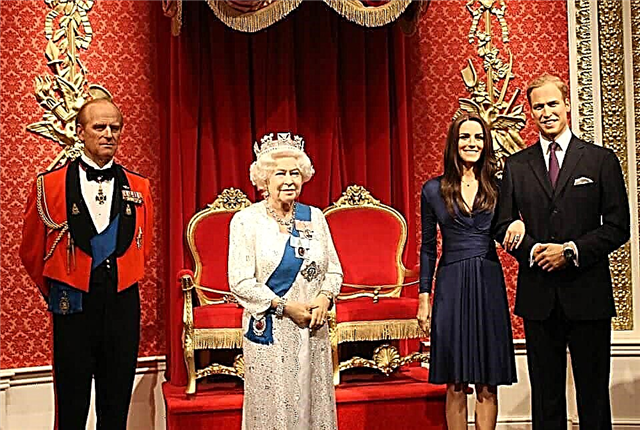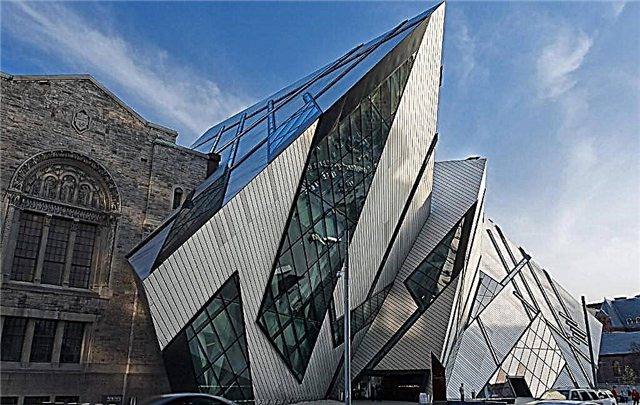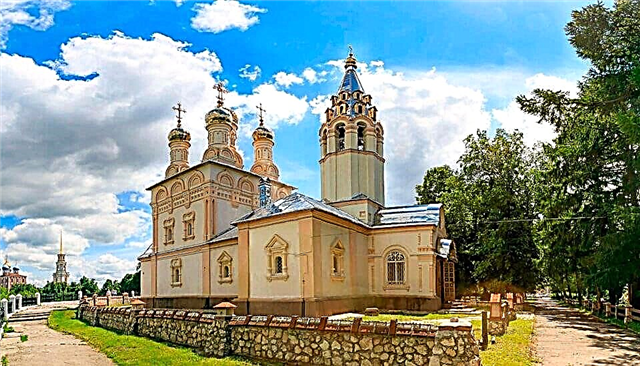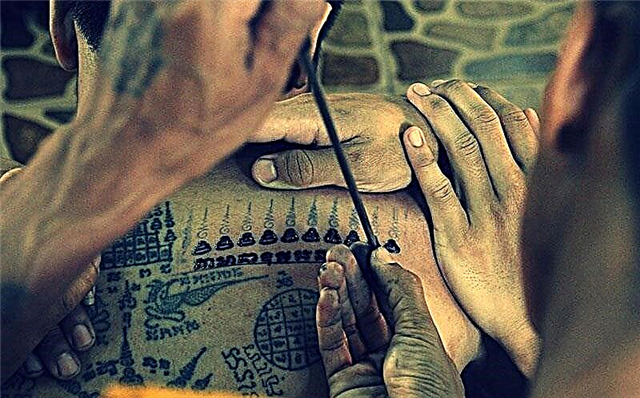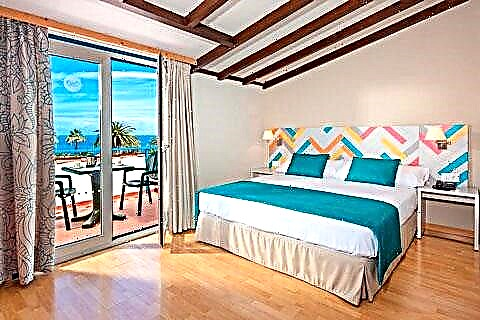Address: Russia, Moscow, st. Taganskaya
Foundation date: 1635 year
Main attractions: Church of the Intercession of the Most Holy Theotokos, Church of the Resurrection of the Word
Shrines: relics of the blessed eldress Matrona of Moscow, the icon of the Mother of God "Seeking the Perished"
Coordinates: 55 ° 44'17.8 "N 37 ° 40'13.2" E
Object of cultural heritage of the Russian Federation
Content:
The old monastery is located in the city center, near the intersection of Taganskaya and Abelmanovskaya streets. Despite the dense development, it is very quiet and green here. Every day, thousands of people come to the Intercession Cathedral to pray near the shrine with the relics of St. Matrona of Moscow.

General view of the monastery
History of the monastery
In the fall of 1633, on the day of the feast of the Intercession of the Mother of God, Patriarch Filaret died. He was the father and co-ruler of the Russian Tsar and during his lifetime he bore the title of "Great Sovereign". Two years later, Tsar Mikhail Fedorovich, wishing to perpetuate the memory of his parent, founded a new monastery in Moscow.
The monastery began to be erected in a cemetery, where wanderers and homeless people were buried, and therefore it was called Bozhedomsky or the abode on the Miserable Houses. The construction of wooden cells and temples was completed by the son of Mikhail Fedorovich - Alexei Mikhailovich. He invested in the monastery the money received for the lease of land plots, and because of this, the people called the monastery "room".

View of the bell tower and cathedrals of the monastery
As in other monasteries in Moscow, at first all the buildings of the monastery were wooden, but in the middle of the 17th century the first stone Pokrovsky Cathedral was built here. Then a three-tiered bell tower and a large brick church in honor of the Resurrection of the Word appeared in the monastery.
During the war with the French, Count Michel Marie Claparede settled on the territory of the monastery, who was an active participant in the Napoleonic wars and commanded the Polish corps. The French soldiers did not spare the ancient monastery. They looted all the valuables and destroyed some buildings.

View of the monastery from Taganskaya street and the northern gate
In the second half of the 19th century, the monastery was rebuilt, and it received the status of a missionary. An educational institution was created here to train monks who went on missionary trips. The teachers did an excellent job with their duties, and by the beginning of the last century, the monastery was able to prepare several dozen Christian missionaries.
With the advent of the new government, the fate of the old monastery changed. In 1926, all the monastery churches were closed, the bell tower was blown up, and three years later the Bolsheviks liquidated the monastery itself.

Holy gates
The large monastery necropolis covered an area of 5.4 hectares and was considered one of the largest in the city. Many well-born Muscovites were buried in this cemetery - collector Pyotr Shchukin, merchants Khludovs, members of the Botkin family, poet and translator Dmitry Glebov and representatives of the Georgian aristocracy. In 1934, in the midst of an active anti-religious campaign, the necropolis was torn down, and stone tombstones from old graves were sold to everyone as a building material. Instead of a cemetery, a park of culture and recreation was set up for residents of the district.
For many years, the monastery buildings and former temples were used for other purposes. They housed the editorial office of the magazine, a film studio and a billiard room. Inside the monastery there was a sports hall and a football field. The Intercession Cathedral was divided by interfloor ceilings, and the building housed a printing house and various departmental organizations.

On the territory of the monastery
The monastery was returned to the believers in 1994. At the same time, it was decided to renew the female Orthodox monastery in the old place. A year later, the first church service after a long break was held in the Intercession Church. At the very beginning, believers prayed in front of a plywood iconostasis, on which paper reproductions of icons were hung. In 1998, the relics of Matrona of Moscow were transferred from the Danilovskoye cemetery to the monastery, and the monastery became a place of mass pilgrimage.
Holy Matron
The saint, revered by believers, was born in 1881 in one of the villages of the Tula province, and died at the age of 71 in Skhodnya near Moscow. Matrona Dmitrievna Nikonova was blind from birth. Her parents - simple peasants at first wanted to leave the child in the orphanage, but then changed their minds.

Church of the Intercession of the Most Holy Theotokos
The girl grew up devout and possessed a healing gift. The wife of a local landowner often took her on pilgrimage trips, so Matrona managed to "see" many holy places and famous Russian monasteries. After the revolution, the woman and her friend moved to Moscow. Here Matrona, like other believers, endured a lot of oppression from the authorities, however, she managed to avoid arrest.
Every day up to 40 people came to the house of the blessed one who wanted to receive advice and be healed. For several years Matrona lived on the Arbat, and in 1950 she moved to distant relatives in Skhodnya. When the healer died, she was buried in the cemetery of the Danilov Monastery.

Church of the Resurrection of the Word
After the relics of the blessed one were transferred to the Intercession Monastery, an Orthodox chapel was built over the former grave. Matrona is considered one of the most revered Russian saints, and several churches located in different cities of the country are dedicated to her.
Architectural monuments and shrines
The architectural ensemble of the monastery was formed in the 19th century. The oldest monastery church, the Cathedral of the Resurrection Slovushche, was founded in the 18th century. Several decades later, it was overhauled by the famous Russian architect Mikhail Bykovsky. As conceived by the architect, the old church became an organic part of the new cathedral.

Monastery bell tower
The five-domed building and its interiors are made in the best traditions of the Russian-Byzantine style. The middle part of the temple is set aside for the main throne in honor of the Resurrection of Christ. The northern side-altar is dedicated to the Tikhvin Icon of the Mother of God, and the southern side - to Saint Alexandra. A spacious bright refectory adjoins them. The cathedral has been beautifully restored, and inside it you can see wall paintings made by talented masters of the 19th century.
To the east of the Resurrection Cathedral is the picturesque one-dome Pokrovsky Cathedral. The majestic building was built at the beginning of the 19th century in the classicism style and is decorated with flat porticoes with strict triangular pediments. It was built on the site of the old wooden Church of the Intercession, from which the Bozhedomsky Monastery began.

Chapel of water
A silver shrine with the relics of the blessed one is kept inside the church, and an icon with the face of St. Matrona is fixed on the outer wall of the building. By tradition, everyone who comes here brings flowers with them, and their number must necessarily be odd, as for a gift to a living person. In memory of visiting the shrine, pilgrims are handed a box with rose petals or buds.
A slender three-tiered bell tower rises next to the Intercession Church. The old baroque bell tower of the 18th century was blown up by a decision of the authorities in 1926. The building that can be seen today was built in the early 2000s, and the bells for it were cast by the masters of the Tutaevsky Bell Factory.

Icon of Matrona of Moscow on the facade of the Church of the Intercession of the Most Holy Theotokos
To the north of the Resurrection Cathedral there is a small, elegant Vodosvyatskaya chapel. Many pilgrims come here to collect holy water. The containers do not have to be brought with you, they are sold right next to the source. In addition to temples and chapels, several stone buildings of the 18th-19th centuries and a red-brick fence with towers and gates have survived on the territory of the monastery.
The monastery today
The Intercession Monastery is an active nunnery, and its doors are open daily for believers and tourists.The monastery is home to about 50 nuns, and there is an almshouse and an orphanage for girls.

Iconography of St. Matrons on the north side of the bell tower
From Monday to Saturday, the territory of the monastery can be accessed from 7.00 to 20.00, and on Sundays and holidays - from 6.00 to 20.00. It should be borne in mind that it is always crowded here. Up to 3000 believers come to the monastery on weekdays. On weekends and on church holidays, their number increases by 10-15 times, and many hours line up of those wishing to visit the Intercession Church.
A monastery hotel with a chapel was recently rebuilt. This is a modern five-star hotel with a swimming pool, suites and a large refectory that can accommodate pilgrims visiting Moscow.
The green area located to the west of the main complex of the monastery is called Tagansky Park. Here, on the site of the destroyed necropolis, a large worship cross was erected, and believers always come to it.

Bow cross
How to get there
The territory of the monastery is located 4.5 km southeast of the Moscow Kremlin. It is easy to reach it in 15 minutes from the metro stations "Marksistskaya", "Taganskaya", "Krestyanskaya Zastava" or "Proletarskaya". Near the entrance to the monastery - on Taganskaya Street and the Abelmanovskaya Zastava Square, many city buses and trams stop.

